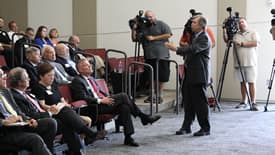Slow economic growth to continue for North Carolina

The North Carolina economy is expected to continue the slow growth pattern of the past eight years, with strong indicators from low unemployment rates and long-term projections for GDP growth, UNC Charlotte professor and economist John Connaughton said.
In 2017, the North Carolina economy is expected to increase by an inflation-adjusted rate of 1.9 percent over the 2016 level, said Connaughton during the Barings/UNC Charlotte Economic Forecast at UNC Charlotte Center City on Thursday, Sept. 7.
Gross State Product (GSP) is expected to reach a level of $536,963.3 million in 2017. The recently released Bureau of Economic Analysis quarterly state GDP shows that for the first quarter of 2017, North Carolina GSP increased by an annualized real rate of 0.6 percent. During the second quarter, GSP is expected to increase by an annualized real rate of 2.3 percent. In the third quarter, GSP is expected to record an annualized real growth rate of 2.2 percent. In the fourth quarter of 2017, GSP is expected to grow by an annualized real rate of 2.1 percent.
Connaughton said, “During the first quarter of 2017, the North Carolina economy seemed to be experiencing very slow growth, which was consistent with the 1.2 percent first quarter growth experienced by the U.S. GDP. The expectation is that growth should pick up in the second quarter which again would be consistent with the U.S. GDP experience.”
He added, “During the third and fourth quarters of 2017, both North Carolina and the U.S. economy should continue to expand at around a 2 percent rate. This would be consistent with the expected long term growth forecast by the Congressional Budget Office (CBO). The CBO January 2017 Economic Outlook forecast the average GDP growth between 2017 and 2027 to be at 1.8 percent per year.”
Seasonally adjusted nonagricultural employment in North Carolina is expected to reach 4,443,200 persons in December 2017, an increase of 1.4 percent more than the employment level in December 2016. The state is expected to add 60,500 net jobs during the year. The sectors with the strongest employment increases in 2017 are business and professional services at 4 percent, educational and health services at 2.6 percent, and hospitality and leisure services at 2 percent.
The United States started 2017 with an unemployment rate of 4.8 percent, which has declined to 4.3 percent by July. North Carolina started the year with a 5.3 percent rate of unemployment, which declined to 4.1 percent by July. By December of 2017, the North Carolina unemployment rate is expected to remain around 4 percent and by December 2018 the unemployment rate is expected to be around 3.8 percent.
“Positive economic growth in 2018 would represent the ninth consecutive year of economic growth for the North Carolina economy. While this is an impressive string of growth, the size of that economic growth has been somewhat lacking. In fact, for most of the 21st Century, both the U.S. and North Carolina economies have been unable to achieve an average 3 percent real GDP growth rate that had been fairly consistent since WWII. In fact, the last time the North Carolina economy exceeded 3 percent GDP growth was in 2006,” Connaughton stated.
He presented his quarterly forecast as part of the Barings/UNC Charlotte Economic Forecast organized by Barings and the UNC Charlotte Belk College of Business.